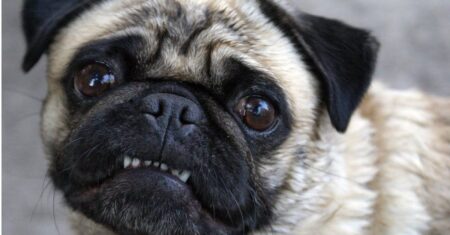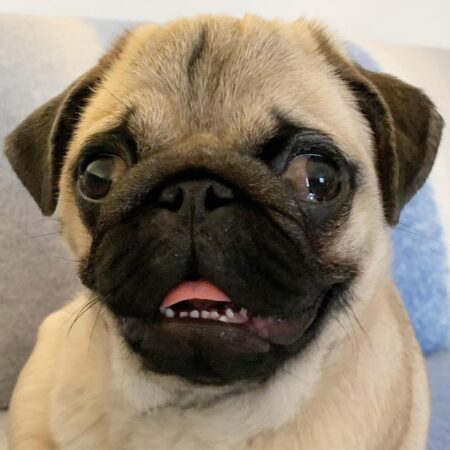Pugs are a beloved breed known for their playful and affectionate nature. Like all dogs, they go through a developmental stage where their baby teeth fall out and are replaced by adult teeth. This process, known as teething, can be intimidating for new pet owners. In this article, we will discuss when pug puppies typically begin teething, how long it will last, and what you can do to help your pug through this crucial stage of their development. By understanding the teething process, you can ensure that your pug stays healthy and comfortable during this time.
When Do A Pugs Baby Teeth Fall Out?
A Pug’s baby teeth will typically start to fall out (or “shed”) between 3-5 months of age. This process is called teething and it can be uncomfortable for the puppy. All of the baby teeth should be gone by the time the pup is 8 months old. If any baby teeth are still present after this time, it is recommended to consult a veterinarian for possible extraction.
What Kind of Teeth Do Pugs Have?
Pugs have small, round teeth that are adapted for eating and grinding small, soft food such as kibble or canned wet food. Their teeth are often crowded and may overlap, making it important for pug owners to regularly brush their dog’s teeth to prevent plaque and tartar buildup. Pugs are also prone to dental issues such as crowding, misalignment, and periodontal disease, so it is important to take good care of their teeth from a young age. They have a total of 42 teeth, which is the same as most other dog breeds.
How Many Teeth Do Pugs Have?
Pugs typically have 42 teeth, just like most other dogs. This includes 12 incisors, four canines, 16 premolars, and 10 molars. As with all dogs, the deciduous (baby) teeth come in first and then fall out as the permanent teeth come in. This process usually happens between 3-6 months of age. It’s important to make sure that your Pug gets regular dental care, including professional cleanings, to keep their teeth healthy and prevent dental disease. If you notice any issues with your Pug’s teeth, be sure to consult your veterinarian.
The Teething Stage of A Pug Puppy
The teething stage for a Pug puppy can be a difficult time for both the puppy and their owner. This stage usually lasts from around 3-6 months of age. During this time, the puppy’s baby teeth are falling out and being replaced by their adult teeth. This can be uncomfortable for the puppy and cause them to chew on things more frequently. It’s important to provide your puppy with plenty of safe and appropriate chew toys during this time. You should also be patient and understanding, as they may be more irritable than usual. The good news is that the teething stage is temporary and will end soon!
Signs of Teething in Pug Puppies
- Excessive Drooling: One of the first signs of teething in puppies is excessive drooling. As their teeth are coming in, they may have a harder time keeping their mouths closed, leading to more saliva.
- Chewing and Biting: As puppies begin to feel the discomfort of teething, they will often start to gnaw on anything they can find to help relieve it. This can include their toys, your furniture, or even your fingers.
- Swollen Gums: As their new teeth push through the gums, you may notice red or swollen areas on your puppy’s gums. This can be uncomfortable for them and can also make their gums sensitive to touch.
- Loss of Appetite: Teething can be uncomfortable for puppies, making it difficult for them to eat or causing them to lose interest in their food altogether. This is a temporary issue and should be resolved once the teething process is over.
- Irritability: Just like human babies, teething can make puppies irritable and fussy. They may seem more cranky than usual and have less patience for play and cuddles.
- Bleeding Gums: In some cases, teething can cause a small amount of bleeding from the gums. This is normal and should stop once the tooth has fully erupted.
- Bad Breath: As your puppy’s new teeth are pushing through the gums, bacteria and food particles can get trapped in the area, causing bad breath. This should improve once the new teeth have fully emerged.
- Changes in Behavior: Some puppies may exhibit changes in behavior during teething. They may be more clingy, anxious, or even more aggressive due to the discomfort they are feeling.
When Do Pugs Stop Teething?
The teething stage for a Pug usually ends around 6 months of age. However, it’s important to remember that all dogs are different, and the teething stage may last longer or shorter for some. Some puppies may be done teething as early as 4 months old, while others may not stop until 8 months of age. However, by 6 months old, most puppies will have all of their adult teeth and will have stopped chewing as much. This is a good time to start brushing your Pug’s teeth regularly to keep them healthy. You can also start introducing dental chews to help keep their teeth clean.
How to Tell if Your Pug is Having Dental Problems
If your Pug is having dental problems, there are a few things you can look for. One sign is excessive drooling or bad breath. Another sign is red or swollen gums. You may also notice your Pug pawing at their mouth or refusing to eat. If you notice any of these signs, it’s important to take your Pug to the vet for a check-up.
SEE ALSO: How Long To Boil Chicken For Dogs?
Pugs Teeth Problems
- Malocclusion: This is a condition where the upper and lower teeth do not meet properly when the mouth is closed. It can lead to difficulty eating and discomfort for the Pug. Malocclusion can be caused by genetics or acquired due to poor dental hygiene.
- Periodontal disease: This is a term for different diseases that affect the structures supporting the teeth, such as the gums, ligaments, and bones. In Pugs, periodontal disease typically starts with tartar buildup that leads to inflammation and infection of the gums. Without prompt treatment, it can progress to more serious problems, including tooth loss and infection.
- Tooth decay: Pugs can develop cavities in their teeth, just like humans. This is usually caused by a combination of poor dental hygiene and a diet high in sugary foods. If left untreated, tooth decay can lead to pain, infection, and even loss of teeth.
- Brachycephalic airway syndrome: This is a condition specific to brachycephalic breeds like Pugs, characterized by shortened upper jaws and compressed airways. This can cause overcrowding of teeth, leading to crooked or misaligned teeth, as well as difficulty eating and breathing.
- Missing teeth: Pugs are prone to having missing teeth, particularly the premolars. This can be caused by genetics or trauma to the mouth. Missing teeth can lead to difficulty eating and can also affect the alignment of remaining teeth.
- Enamel hypoplasia: This is a condition where the enamel, the hard outer layer of the tooth, is not fully developed or is weakened. Pugs with enamel hypoplasia may experience tooth sensitivity, discolored or pitted teeth, and an increased risk of developing dental problems.
- Broken or fractured teeth: Pugs are at higher risk for breaking or fracturing their teeth due to their short snouts and small mouths. This can happen from chewing on hard objects or from accidents. Broken or fractured teeth can be painful and may require extraction if severe.
- Oral tumors: Pugs can develop tumors in their mouths, which can be benign or cancerous. These can affect the teeth and cause pain if they grow or become infected. If found early, oral tumors can often be successfully treated.
How to Properly Care for Your Pug’s Teeth
To keep your pug’s teeth in tip-top shape, follow these tips for proper dental care:
- Start Young: The best way to ensure good dental health for your pug is to start while they are still young. Introduce them to teeth brushing and dental care at a young age so they become accustomed to the routine.
- Brush Your Pug’s Teeth: Ideally, you should be brushing your pug’s teeth at least three times a week. Use a small soft-bristled toothbrush and canine-specific toothpaste. Gently brush their teeth in a circular motion, focusing on the gum line.
- Have Regular Dental Checkups: Just like humans, pugs should have regular dental checkups with their veterinarian. This will help catch any potential problems early on and ensure your pug’s teeth are in good health.
- Choose the Right Food: Your pug’s diet can also play a role in their dental health. Consider choosing a high-quality food with ingredients that promote good oral health, such as antioxidants and enzymes.
Recommended Pug teething toys
- KONG Puppy Teething Stick: The KONG Puppy Teething Stick is a durable rubber toy that is gentle on a puppy’s teeth and gums. The unique shape and texture promote healthy chewing and alleviate teething discomfort. It also has a hollow center for filling with treats, providing mental stimulation and rewards for your pup’s chewing efforts.
- Nylabone Puppy Teething Keys: Nylabone Puppy Teething Keys are made from durable nylon and are designed to satisfy a puppy’s natural urge to chew. The different textures and ridges help clean teeth and soothe sore gums. They are also infused with a chicken flavor for added attraction.
- Petstages Dogwood Stick: The Petstages Dogwood Stick is a natural alternative to traditional chew toys. It is made from real wood and combined with synthetic materials to create a safer, splinter-free experience for your pup. The shape and texture of the stick also help massage gums and clean teeth while your pup chews.
- Chuckit! Ultra Ball: The Chuckit! Ultra Ball is a durable and bouncy toy that is perfect for teething puppies. Its high bounce and buoyancy make it great for outdoor play and it is also compatible with the Chuckit! ball launchers for longer throwing distances. The textured surface helps promote healthy chewing and soothes teething discomfort.
- Benebone Real Flavor Wishbone Chew Toy: The Benebone Real Flavor Wishbone Chew Toy is made from real bacon, peanut butter, or chicken for an irresistible flavor. The unique wishbone shape is designed for easy holding and chewing. It is also made from tough nylon material for long-lasting use.
Should I Be Concerned If My Pug Is Losing Teeth?
If your Pug is losing teeth, you don’t need to be concerned unless they are very young (less than 3 months old) or very old (over 10 years old). Puppies start to lose their baby teeth around 3-4 months old. This is a normal part of the teething process and nothing to worry about.
SEE ALSO: Why Do Huskies Scream?
FAQs
Q. Why is my pug losing her teeth?
A. While pugs typically don’t lose their teeth until they’re seniors, there are a few reasons why your pug might be losing her teeth at a younger age. The most common reason is a condition called periodontal disease, which is caused by bacteria that build up on the teeth and gums. This can lead to inflammation, bleeding, and eventually tooth loss. Other possible causes of tooth loss in pugs include trauma to the mouth, poor nutrition, and certain medical conditions.
Q. At what age do puppies lose most of their teeth?
A. Most puppies start losing their baby teeth around 4 months of age. The process of losing baby teeth, also known as teething, can last until a puppy is 8 months old.
Q. How many teeth should a pug have?
A. A healthy adult pug should have 42 teeth, consisting of 12 incisors, 4 canines, 16 premolars, and 10 molars.
Q. Are pugs prone to dental disease?
A. Pugs are indeed prone to dental disease, which is a common problem in small-breed dogs. The flat face and compressed jaw of a pug make it difficult for them to clean their teeth properly, which can lead to plaque and tartar buildup.
Conclusion
In conclusion, a Pug’s baby teeth will start to fall out around 3-4 months of age and will be fully grown by 6-7 months. It is important to monitor your Pug’s teething process and provide them with appropriate chew toys to help alleviate any discomfort. If their baby teeth do not fall out as expected, consult with a veterinarian for proper guidance.


